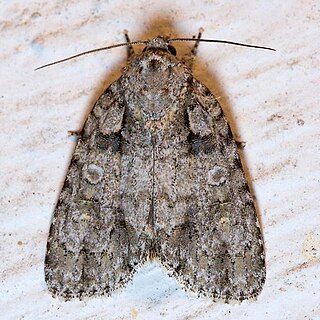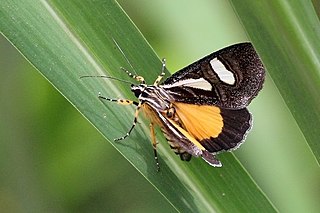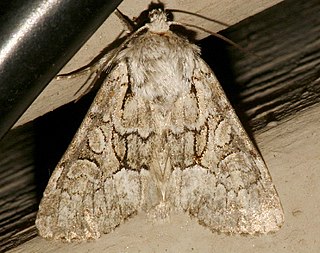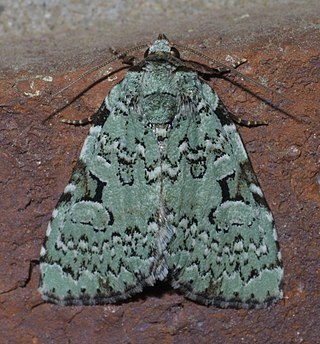
Acronicta increta, the raspberry bud dagger moth, raspberry bud moth or peach sword stripe night moth, is a moth of the family Noctuidae. The species was first described by Herbert Knowles Morrison in 1875. It is distributed throughout the south of Canada and the United States down to Florida and Texas.
Inopsis is a genus of moths in the family Erebidae. The genus was described by Felder in 1874.

Ptychoglene is a genus of moths in the subfamily Arctiinae. The genus was erected by Felder in 1874.

Xanthothrix is a genus of moths of the family Noctuidae. The genus was erected by Henry Edwards in 1878.

Agoma is a monotypic moth genus of the family Noctuidae erected by Sergius G. Kiriakoff in 1977. Its only species, Agoma trimenii, or Trimen's false tiger, was first described by Rudolf Felder in 1874. It is known from most countries of subtropical Africa.

Annaphila is a genus of moths of the family Noctuidae. The genus was erected by Augustus Radcliffe Grote in 1873.

Aseptis is a genus of moths of the family Noctuidae. The genus was erected by James Halliday McDunnough in 1937.
Diastema is a genus of moths of the family Noctuidae. The genus was erected by Achille Guenée in 1852.

Eremobina is a genus of moths of the family Noctuidae erected by James Halliday McDunnough in 1937.

Eulithosia is a genus of moths of the family Noctuidae erected by Henry Edwards in 1884.
Hemicephalis is a genus of moths of the family Erebidae. The genus was erected by Heinrich Benno Möschler in 1890.

Leuconycta is a genus of moths of the family Noctuidae. The genus was first described by George Hampson in 1909.
Neotuerta is a genus of moths of the family Noctuidae. The genus was erected by Sergius G. Kiriakoff in 1977.

Ophthalmis is a genus of moths of the family Noctuidae. The genus was erected by Jacob Hübner in 1819.

Phobolosia is a genus of moths in the family Erebidae. The genus was erected by Harrison Gray Dyar Jr. in 1908.

Plagiomimicus is a genus of moths of the family Noctuidae. The genus was erected by Augustus Radcliffe Grote in 1873.

Tarache is a genus of moths of the family Noctuidae erected by Jacob Hübner. It includes most former New World Acontia species. Lepidoptera and Some Other Life Forms and The Global Lepidoptera Names Index report this name as a synonym of Acontia.

Tripudia is a genus of moths of the family Noctuidae. The genus was erected by Augustus Radcliffe Grote in 1877.
Chrysopeleia is a genus of moths in the family Cosmopterigidae. The genus was erected by Vactor Tousey Chambers in 1874.













